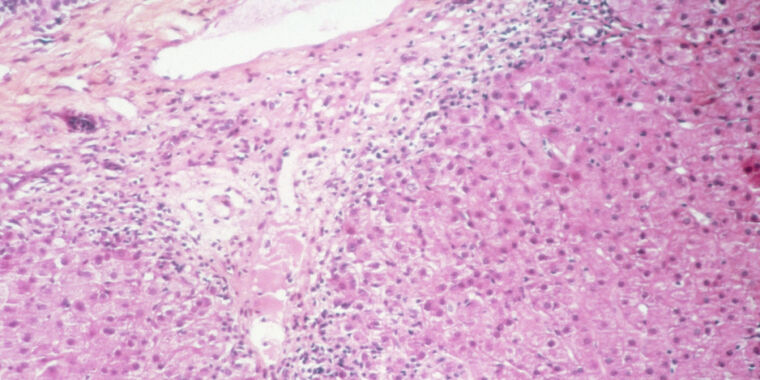
The US Centers for Disease Control and Prevention has ruled out the pandemic coronavirus, SARS-CoV-2, as a possible cause of the puzzling, international outbreak of severe hepatitis (liver inflammation) in children, according to a statement released Friday.
The outbreak has sickened more than 170 children in more than a dozen countries in recent months, with case counts ticking up by the day. Around 10 percent of the children—mostly under the age of 10—have required liver transplants. The World Health Organization has reported one death.
In the US, officials in at least five states have reported at least 25 confirmed or possible cases: Alabama (9), North Carolina (2), Wisconsin (4), Illinois (3), and California (7). At least three of the US cases have required liver transplants and officials in Wisconsin are investigating a possible death linked to the outbreak.
Like other public health agencies around the world investigating the outbreak, the CDC’s leading hypothesis is that an adenovirus is behind the cases. Adenoviruses are a large family of viruses not known to cause hepatitis in healthy children. They’re most often associated with common colds but also gastroenteritis and conjunctivitis (pink eye). However, many of the children affected by the severe hepatitis outbreak—who were previously healthy—have tested positive for an adenovirus.
Hypotheses
Still, some international health agencies have kept open the possibility that SARS-CoV-2 could also be involved in the cases. In a technical briefing document released earlier this week by the UK Health Security Agency, officials noted that SARS-CoV-2 was the second most common infection identified in the cases after adenovirus. And their top working hypothesis includes two scenarios involving SARS-CoV-2. The leading hypothesis is:
1. A cofactor affecting young children that is rendering normal adenovirus infections more severe or causing them to trigger immunopathology. The cofactor may be:
- susceptibility, for example, due to lack of prior exposure during the pandemic
- a prior infection with SARS-CoV-2 or another infection, including an omicron restricted effect
- a coinfection with SARS-CoV-2 or another infection
- a toxin, drug, or environmental exposure
The UK officials also listed a new variant of SARS-CoV-2 as the possible cause, though it was the hypothesis considered the worst fit with the data so far.
The CDC meanwhile has apparently ruled out SARS-CoV-2 entirely, according to Friday’s statement, though the agency has not drawn a firm conclusion on the cause. The statement read (emphasis theirs):
“At this time, we believe adenovirus may be the cause for these reported cases, but other potential environmental and situational factors are still being investigated. …Some causes have already been ruled out, including:
- hepatitis viruses A, B, and C
- SARS-CoV-2 infection
- autoimmune hepatitis
- Wilson disease [a rare genetic disorder in which copper accumulates in organs]
Details
The statement follows additional details on nine of the US cases, all from Alabama, published Friday in the CDC’s Morbidity and Mortality Weekly Report by CDC and other public health experts. The data doesn’t offer much additional insight into the cause of the cases. But, it does note that none of the nine children had a documented history of previous SARS-CoV-2 infection, and none tested positive for the virus, which may explain why the CDC ruled out SARS-CoV-2.
Instead, all nine tested positive for adenovirus, and typing done on five of the patients identified adenovirus type 41 in all five cases. Like all other adenoviruses, type 41 is not known to cause hepatitis in healthy children. The MMWR authors note: ” Adenovirus type 41 is primarily spread via the fecal-oral route and predominantly affects the gut. It is a common cause of pediatric acute gastroenteritis typically with diarrhea, vomiting, and fever, often accompanied by respiratory symptoms.”
Those symptoms match the initial symptoms reported by the nine cases, with seven reporting vomiting, six reporting diarrhea, five with fever, and three with respiratory symptoms. But unlike a typical adenovirus type 41 infection, the children then developed yellowing eyes, enlarged livers, jaundice, elevated liver enzymes, and one child developed encephalopathy. Three of the children had acute liver failure, and two required liver transplants. They are all reported to be recovered or recovering.
The report also listed their ages: Five of the children were between 0 and 2, one child was between the ages of 3 and 4, and three were between the ages of 5 and 6.
At the time of the illnesses, seven of the nine children tested positive for other viruses besides adenovirus. Six of the nine had signs of a prior Epstein-Barr virus (EBV) infection. Other viruses detected include enterovirus/rhinovirus (four positive of eight cases tested), metapneumovirus (one of eight), respiratory syncytial virus (one of eight), and human coronavirus OC43 (one of eight). UK officials have also noted EBV and enterovirus in a small fraction of their cases but have not identified any co-infection besides SARS-CoV-2 as a prime suspect.








